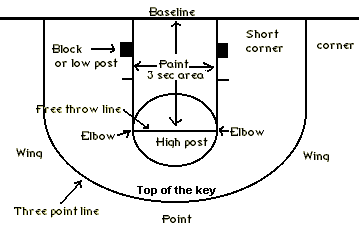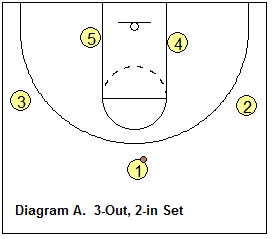Basketball Terms- Terminology
By Dr. James Gels, From the Coach’s Clipboard Basketball Playbook"Helping coaches coach better..."
See more comments...
Watch Video Register now
Like any sport or discipline, basketball has its own language. A novice could listen to two coaches talking to each other and not have any idea of what they are talking about! This is true in almost any subject. Studying to become a doctor, you first have to know the names of all the parts before you can operate on them!
How do we come up with all these terms? It is an evolutionary process over the years. An expert coach uses some new term at a basketball camp, and it becomes part of the vernacular. A colorful TV commentator (Al McGuire and his "aircraft carrier", Dick Vitale, etc) come up with very colorful expressions, and it becomes part of the game.
This page will be like a basketball dictionary, defining basketball terms. Realize that sometimes coaches don't completely agree on what something means, and sometimes we have more than one term for the same thing... e.g. a "screen" and a "pick" (same thing to me).
This page can be a work in progress. If any one has a term to add to this list, or disagrees with my definition, please email me.
First, lets look at the "half-court" diagram to define areas of the floor.

The "paint" is the area inside the lane lines from the baseline to the free-throw line. If your offensive player has a foot on, or inside these lines for 3 seconds or longer, he will be called for the 3-second violation. There is no restriction on the time defensive players can occupy the paint.
"Free throw line", ("charity stripe") is the line you must stand behind when shooting a free-throw.
"High post" is that area along the free throw line, and both "elbows".
The "point" is out front, and the "wings" on either side. The "top of the key" is above the free-throw circle (many years ago, the lane was not as wide as the free-throw line and circle, and so it looked like a key, or keyhole). The two "slots" are the spots at the 3-point arc, lane lines extended, so on either side of the top of the key. The "short corner" is between the corner and the basket, about 12 feet out.
"Ball-side", or strongside, refers to the side of the floor where the ball is. "Weak-side" is the opposite side away from the ball. Players cutting on the weak-side toward the hoop, are using the "back-door".
"10 second line", or half-court line, is the line down the center of the floor. It divides the "full-court" (entire playing area) into two "half-courts". Your "fore-court" is the half-court with your basket, and the "back-court" is the half-court with the opponent's basket. Once a team gets possession of the ball, it has 10 seconds to get the ball across the half-court line into its fore-court.
Once across this line (all three points - the ball and both feet), they may not pass or dribble the ball back across this line, or step on the line (while having possession) or the "over and back" violation occurs. The offense may retrieve the ball without penalty if deflected across by a defensive player.
Numbering players, offensive terminology.
Years ago, numbers were not used. You usually had two "guards" who played the "perimeter" and brought the ball up the floor. The "center" usually played around the high-post area, and the two "forwards", started in the short corner to corner areas, extending out to the wings.
Now, most coaches use a numbering system, as the old definitions often do not apply any more, with players playing in multiple offensive formations. Using a numbering system, makes it easier for coaches and players to understand plays, sets, and know their roles. Different numbering systems exist and coaches have their own favorite ways of doing this. Here is the numbering system that I use, which I feel is very easy for young players to learn. The diagram below shows a "3-2 set".

The "point guard" is O1. The right "wing" is O2, and the left wing is O3. The right low post is O4, and the left low post is O5. O2 is usually the shooting guard, O3 is the small forward, O4 is the power forward, and O5 is the center or strong post player.
This is easy for young players to learn if you tell them that the even numbers (2 and 4) are on the right side, and the odd numbers (3 and 5) are on the left.
In this set, you have three guards, or "perimeter players", and two "post players", rather than the old definition of two guards, two forwards and a center.
In a "1-3-1 set", you would bring one of the low posts up to the high-post area. In a "1-4 set", you bring both post players up to the elbows ("stack offense"), or you can drop both wings down to the corners ("low stack"). You could use a "4-out, 1-in offense" with four perimeter players and one post player. The "open post offense" (5-out) is yet another.
"Pick and roll" - a play where an offensive player sets a "screen" ("pick") on a team-mate's defender, thereby freeing up the team-mate, after which the screener moves, or "rolls" off the screen to the hoop ("pick and roll"), or an open perimeter area for the return pass ("pick and pop"). There are a number of types of screens: ball-screen, back-screen, down-screen, lateral screen, flare screen, floppy screen, ghost screen, blur screen, screen your own, cut-screen, Spain pick and roll - see Setting and Using Screens for descriptions.
"Give and go" - a very basic play where after passing to a team-mate, the passer quickly cuts toward the basket, and receives the return pass back from his team-mate for the lay-up.
"Reverse the ball" - this means to quickly move the ball, by passing, to the opposite side of the fore-court, either by a series of quick passes, or by means of a "skip pass" (a pass directly across court, thereby "skipping" one or more offensive players in the succession around the perimeter). You may want to reverse the ball quickly to "over-shift" a zone defense. By moving some of your offensive players to one side of the floor (e.g. against a zone defense), you "over-load" the zone.
"Post up" - offensive move wherein a low post player positions himself, and "seals" his defender off so that he can receive the pass down low on the block, where he can use a "post move" for a score, or quickly pass the ball back outside to an open team-mate for a three-pointer (going "inside-out"). There are a number of post moves: Drop step baseline, jump-hook to lane, turn and face, up and under, dribble-drop, dream shake, step-out, flash high, backdoor lob, step-hop. See Post Play and Post Moves.
There a terms referring to types of offensive cuts made by players, usually moving without the ball. Rather than re-defining them here, please read the page on "Cutting and Faking".
There are terms that refer to various types of dribble moves (see "Dribbling").
To understand the basketball terms "triple threat position", "jab-step" and perimeter one-on-one moves, see "Guard Moves and Skills".
"Out-of-bounds plays" are used in an attempt to get a quick scoring opportunity when you have to inbounds the ball (either under your basket, or along the sideline.) There are many of these plays to choose from on this website.
There are defensive basketball terms.
Man-to-man defense" - each defensive player is assigned to guard a specific opposing player. He may "switch" his player with another team-mate if he gets screened. Man-to-man defenders must learn the meaning of "on-ball" (defending the player with the ball), "deny" (preventing your man from getting the ball), and "help-side" (sagging off your man to help your team-mates prevent inside "penetration" (see Basic Defense).
The term "close-out", refers to the method in which a defender quickly slides up to, and contains the ball-handler, or ball-receiver.
There are the terms, "on the line" and "up the line". These two terms refer to a defender's position on the floor, relative to the ball-handler and his man. Use this illustration... stretch a rope between the ball-hander and your man (let's say between the point guard and the wing).
"On the line" means your defensive position is such that you can see your man and the ball, and your body is directly on that imaginary line usually with chest toward the player, and head toward the ball with arm up in the passing lane, in a "full denial" situation.
"Up the line" means you are in a position backed off from this imaginary line, toward the basket, in a position where you can see both ball and your man, prevent the "back-cut", and yet be able to force the ball-handler to pass away from your man. The farther apart the ball-hander and the wing player are, the more the defender can drop back "up the line", and still be in position to intercept or deflect the pass.
A "trap" is set when two defenders double-team the ball-handler, trying to force a turn-over or a jump-ball situation.
"front the low post" - on defense, this has to do with how you defend the low post player. The defender can stay between him and the basket, or get out in "front" of him between the low post player and the passer, so as to "deny" him the pass.
"box-out" - what every player should do when a shot goes up... try to block out, or "box-out", the person he is guarding to keep him away from the basket and prevent him from getting "inside position" for the rebound. See "Rebounding Tips, Techniques and Fundamentals".
"Zone defense" - each defender, rather than guarding a specific opposing player, is assigned to guard or cover a certain area of the floor, or zone. These man-to-man and zone definitions are very general and broad, as "a good zone looks like a man-to-man, and a good man-to-man looks like a zone", each incorporating certain aspects of each other, for an overall "team defense".
Many different zone sets are used, 2-3, 3-2, 1-3-1, 1-2-2, etc (see "Zone Defense"). By definition, the term "zone offense" refers to a team's offensive strategy used to defeat a zone defense (see "Zone Offense").
There are various "gimmick" defenses that combine elements of zone defense and man-to-man coverage (e.g. "box and 1", "triangle and 2", etc). See "Junk Defenses" and "Match-up Zone Defense".
"Transition" is the process of changing from defense to offense, or vice-versa. "Transition offense" is the former, and "transition defense" is the latter. Transition offensive strategy may involve a full-court "fast break", or a "secondary break" (see "Transition Offense") wherein the offense attempts to quickly move the ball up the floor in hopes of getting the easy lay-up.
Transition defense may be simply getting back down the floor as quickly as possible on defense, or may involve a "full-court press", which can be man-to-man, or a "zone press" (see "Transition Defense"). Against a full-court press defense, the offense will often use a "press-breaker", a strategy designed to counteract the full-court press.